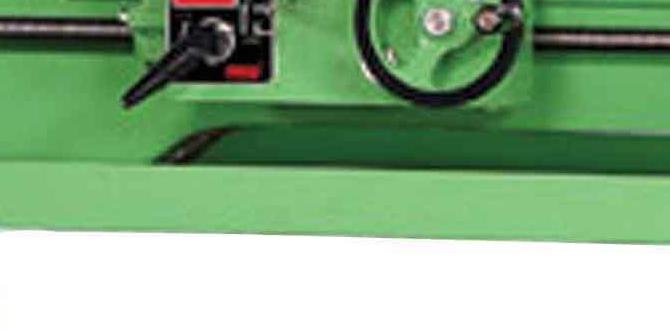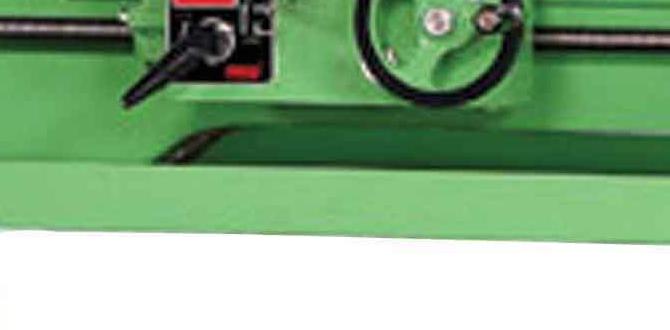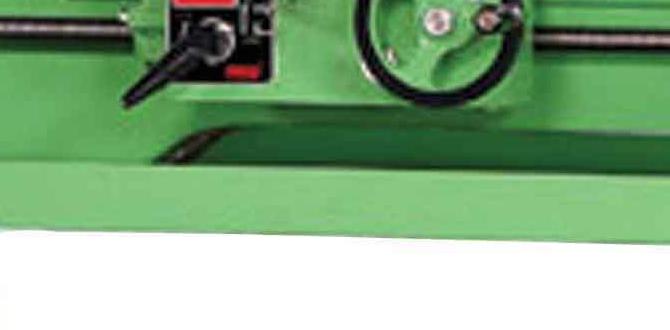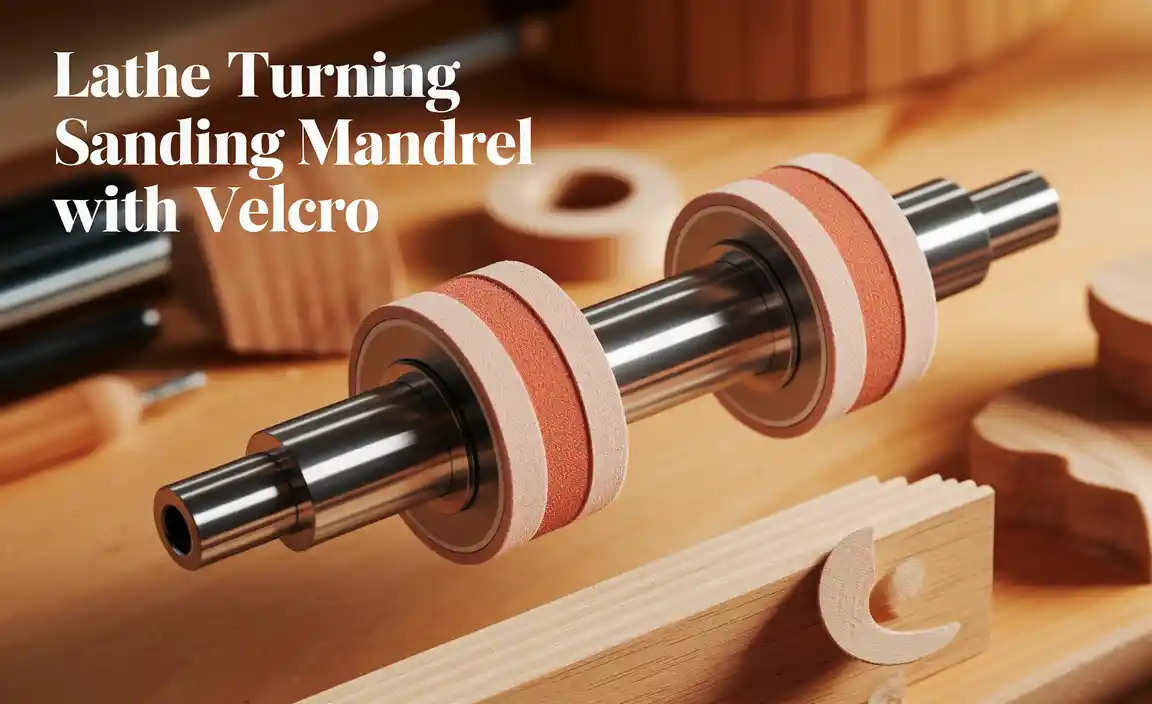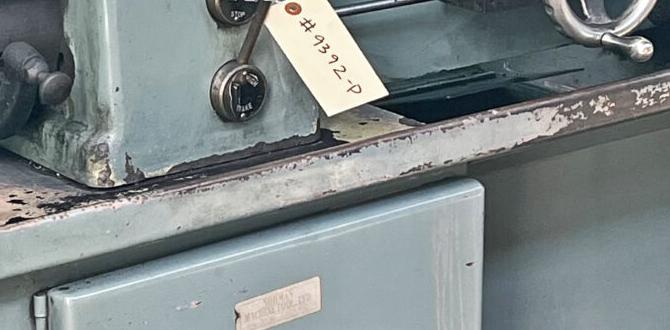Drilling on a lathe is a fundamental skill for creating precise holes in your projects. This guide breaks down how to drill safely and effectively on your lathe, covering essential techniques, tools, and safety tips so you can achieve accurate results with confidence.
Ever found yourself staring at your lathe, a perfectly good piece of material in the chuck, and needing a clean, straight hole right in the center? You’re not alone! Drilling on a lathe can seem a bit intimidating at first. Will the drill bit wander? Will it break? What’s the right speed? These are common questions for anyone new to machining. The good news is, with a little understanding and the right approach, drilling on your lathe becomes a straightforward and incredibly useful skill. This guide will walk you through everything you need to know, making you a confident lathe driller in no time.
Why Drill on a Lathe?
Your lathe is designed for precision rotation, and that’s exactly what makes drilling on it so beneficial. Unlike a drill press or a hand drill, where the workpiece moves, on a lathe, the workpiece spins while the stationary tool (in this case, a drill bit) moves into it. This controlled environment offers several advantages:
- Accuracy: The spinning workpiece ensures the drill enters perfectly on center if set up correctly, leading to straight, true holes.
- Consistency: You can achieve repeatable results, crucial for projects requiring multiple holes or precise alignment.
- Efficiency: With the right techniques, drilling on the lathe can be much faster than other methods for certain operations.
- Surface Finish: The lathe’s stable platform often results in a cleaner hole finish compared to freehand drilling.
Essential Tools for Lathe Drilling
To drill effectively and safely on your lathe, you’ll need a few key pieces of equipment:
- Drill Bits: Standard twist drills (HSS – High-Speed Steel) are common. For harder materials or specific applications, Jobber drills, Stubbies, and even carbide drills might be considered. Ensure they are sharp.
- Drill Chuck: This is the most common way to hold a drill bit on a lathe. It mounts into the tailstock and grips the drill’s shank. Keyed chucks are very common for their strong grip.
- Tailstock: This is the part of the lathe that typically holds drilling accessories. It can be moved along the bed and locked in place.
- Center Punch: Absolutely essential for accurately starting your hole. It creates a small indentation for the drill bit to sit in, preventing it from wandering.
- Mallet or Hammer: Used with the center punch. A rubber mallet is often preferred to avoid damaging the workpiece surface.
- Measuring Tools: Calipers and rulers are needed to determine the correct depth of the hole.
- Eye Protection: Safety glasses or a face shield are non-negotiable.
- Cutting Fluid/Lubricant: Helps to cool the drill bit and workpiece, lubricate the cutting action, and flush away chips, especially when drilling metal.
- Tool Holder (for Milling): If you’re using a milling attachment or a tool post grinder to hold your drill, a suitable holder will be necessary.
Setting Up for Drilling: The Crucial First Steps
Proper setup is paramount. A stray drill bit can ruin a workpiece and be dangerous. Here’s how to get started:
Centering Your Drill Bit
This is the most critical step. If your drill isn’t perfectly centered, your hole won’t be either.
- True the Workpiece: Ensure the material you’re drilling is running true in the headstock chuck. Spin it slowly by hand and check for any wobble or runout.
- Mark the Center: If you need a hole precisely in the center of an end face, use a scriber to mark a cross on the center point.
- Use a Center Punch: Place the tip of the center punch exactly on your mark. Give it a firm rap with a hammer or mallet to create a small conical indentation. This indentation acts as a guide for your drill bit.
Mounting the Drill Bit
The tailstock is your drill holder.
- Insert the Drill Chuck: Mount the drill chuck securely into the tailstock quill. If it’s a keyed chuck, ensure the key is removed before tightening.
- Insert the Drill Bit: Place the shank of the drill bit into the drill chuck. Tighten the chuck firmly using the chuck key, ensuring the bit is held straight and securely.
- Align the Tailstock: This is vital for accurate center drilling. If your tailstock has an offset adjustment, use it to align the drill bit perfectly with the headstock spindle. A common method is to use a dial indicator mounted to the tool post, with its probe touching the side of the drill bit while you slowly turn the headstock by hand. Adjust the tailstock until the indicator shows minimal runout from one end of the drill bit to the other when the headstock is rotated. For simpler setups, you can rest the tip of the drill bit against the workpiece (held in the headstock) and visually align the tailstock to ensure it’s parallel to the lathe bed and aimed directly at the tailstock center (if present).
Drilling Techniques: Step-by-Step
Once set up, you’re ready to drill. Remember to go slow and steady, especially when starting.
Step 1: Advance the Tailstock
Use the tailstock handwheel to carefully advance the quill, bringing the tip of the drill bit into contact with the center punch mark on your workpiece.
Step 2: Engage the Lathe
Start the lathe at a slow speed. The appropriate speed depends on the material being drilled and the size of the drill bit. A good rule of thumb for metal is to use slower speeds for larger drills and harder materials, and faster speeds for smaller drills and softer materials. You can often find charts online with recommended speeds. For wood, speeds can generally be higher.
Step 3: Make the First “Peck”
Apply gentle, steady pressure with the tailstock handwheel to start the drill bit into the material. Just as the bit begins to cut, advance it a small amount (maybe 1/8” or 3mm). Then, immediately retract the drill slightly using the handwheel.
Why do this? This initial peck helps to establish the hole and ensures the drill isn’t going to wander off-center. It also clears away any initial burrs.
Step 4: Continue Drilling with Pecks
Now, begin your drilling in earnest. You’ll want to employ a “pecking” drilling cycle, especially in metal. This means:
- Advance the drill until it’s cutting.
- Advance a short distance.
- Retract the drill almost completely out of the hole.
- Repeat.
Why peck? This clears chips out of the flutes of the drill bit and away from the cutting edge. If chips pack up, the drill can bind, break, or create a rough hole. It also allows coolant to reach the cutting edges and helps to cool both the drill and the workpiece.
Step 5: Apply Lubricant (Metalworking)
If you’re drilling metal, apply cutting fluid or lubricant regularly. You can do this by brushing it onto the drill bit as it enters the workpiece, or by having a stream of coolant aimed at the drilling point. For longer holes, pecking is essential to allow the lubricant to get to the bottom of the hole.
Step 6: Monitor Depth and Chips
Keep an eye on your progress. Use a traveling dial on the tailstock (if you have one) or a measurement from the tailstock quill itself to track depth. Watch the chips being produced – they should be relatively small and consistent for most materials. If they are long and stringy (in metal), your feed rate might be too high, or you might not need to peck as much. If they are powdery and the drill feels like it’s rubbing, your feed rate might be too low or the drill is dull.
Step 7: Breaking Through
As you approach the end of the hole, reduce the feed rate and pressure. This prevents the drill bit from “grabbing” as it breaks through the other side, which can cause tear-out (especially in wood) or damage to the drill itself.
Step 8: Retract Carefully
Once you’ve reached the desired depth or broken through, retract the drill bit straight back out of the hole using the tailstock handwheel. If drilling through, you may want to “ream” the hole slightly as you back out by opening the flutes slightly against the hole’s exit for a cleaner finish.
Drilling Depths and Measuring
Accurately measuring your drilling depth is crucial. Here’s how:
- Tailstock Dial: Many tailstocks have a graduated dial on the handwheel. Each mark usually represents a specific feed per revolution. Learn what your dial’s markings mean, and you can feed the drill a precise distance.
- Traveling Dial: A more precise method. This is a separate dial indicator that clamps to the lathe bed and has a flexible cable that reads the movement of the tailstock quill. It allows you to measure the exact amount the quill has advanced.
- Marking the Quill: For less critical depths, you can mark a line on the tailstock quill and the tailstock body with a piece of tape and advance until the tape markers meet or pass a certain point.
- Visual Inspection: For deep holes, you can sometimes stop the lathe, measure the drilled hole with calipers, divide by two (for the diameter), and then calculate how much more is needed.
Always remember that the measurement on the tailstock dial or traveling dial indicates the distance the quill has moved. You’ll need to account for the fact that the drill bit tip is conical, meaning the actual hole depth will be slightly less than the quill travel for a blind hole, or that the tip must fully exit the material for a through hole.
Speed and Feed Charts: A Starting Point
Choosing the correct spindle speed and feed rate is essential for efficient and safe drilling. These values depend heavily on the material being cut, the type and size of the drill bit, and whether you are using coolant. These are general guidelines and will require adjustment based on your specific setup and experience.
The general formula for cutting speed (v) is ( V = frac{pi D N}{12} ) (in SFM for inches) or ( V = frac{pi D N}{1000} ) (in m/min for millimeters), where:
- ( V ) is the cutting speed (Surface Feet per Minute or Meters per Minute)
- ( D ) is the drill diameter (inches or mm)
- ( N ) is the spindle speed (Revolutions Per Minute – RPM)
This can be rearranged to find RPM: ( N = frac{12 V}{ pi D } ) (for SFM).
Here’s a simplified chart to get you started. Remember that these are recommendations, and experience will teach you to adjust based on sound and chip formation.
| Material | Drill Diameter (inches) | Recommended RPM (Approximate) | Cutting Fluid/Lubrication | Chip Formation (Ideal) |
|---|---|---|---|---|
| Aluminum | 1/4″ | 500-800 | Yes (light oil or dedicated fluid) | Short, thin shavings |
| Aluminum | 1/2″ | 250-400 | Yes | Short, thin shavings |
| Mild Steel | 1/4″ | 200-400 | Yes (essential, use cutting oil) | Curled ribbons, not too fine |
| Mild Steel | 1/2″ | 100-200 | Yes (essential) | Curled ribbons, not too fine |
| Brass | 1/4″ | 600-1000 | Optional (can use water-based) | Fine shavings |
| Brass | 1/2″ | 300-500 | Optional | Fine shavings |
| Wood (Hardwood) | 1/4″ | Higher (e.g., 800-1500 – depends on motor) | No (unless for specific finishes) | Dust and shavings |
| Wood (Softwood) | 1/4″ | Higher (e.g., 1000-2000 – depends on motor) | No | Dusty shavings |
Note: These RPMs are for a typical small to medium-sized metal lathe. Always consult more detailed machining handbooks for precise speeds and feeds for specific alloys and drill types. Organizations like the National Institute of Standards and Technology (NIST) provide foundational data for machining processes.
When to Ream vs. Drill
Drilling creates a hole, but reaming refines it.
- Drilling: Removes material to create a hole of a specific size. It’s a primary machining operation.
- Reaming: A finishing operation performed after drilling. It removes a very small amount of material to produce a smooth, accurate, and precisely sized hole. Reamers have multiple cutting edges that are much shallower than drill flutes.
You typically drill a hole slightly undersized for reaming. For example, if you need a 0.500″ reamed hole, you might drill it to 0.495″ or 0.498″ and then use a 0.500″ reamer to finish it. Reaming is usually done at a slower speed with a constant feed and without pecking.
Common Problems and Solutions
Even with the best intentions, things can go wrong. Here are a few common issues and how to fix them:
| Problem | Possible Cause | Solution |
|---|---|---|
| Drill Bit Wanders/Starts Off-Center | Improper center punch mark; drill bit not seated correctly; tailstock misaligned. | Ensure a sharp center punch mark; firmly tighten drill in chuck; meticulously align tailstock. |
| Drill Bit Binds or Breaks | Excessive feed rate; chips not clearing (failure to peck); dull drill bit; wrong speed; drilling into a hard spot. | Reduce feed pressure; peck drill more frequently; sharpen or replace drill; adjust speed per charts; use appropriate coolant. |
| Poor Hole Finish (Rough Walls) | Dull drill bit; inadequate lubrication; excessive feed rate; workpiece material too soft or gummy. | Sharpen or replace drill; use more/better coolant; reduce feed rate; try pecking more effectively. |
| Drill Bit “Chatters” or Vibrates | Excessive spindle runout; improperly aligned tailstock; dull drill; insufficient rigidity; feed rate too fast or too slow. | Check and correct spindle/tailstock alignment; sharpen drill; ensure workpiece and tool are securely held; adjust feed rate. |
| Drill Bit Gets Hot / Smokes | Insufficient speed; insufficient feed; lack of lubrication; dulled drill. | Increase speed (cautiously) or decrease (if chips are too fine); increase feed (if chips are too long); use ample coolant; sharpen drill. |
Best Practices for Safety
Safety is paramount in any workshop, and the lathe is no exception. When drilling:
- Always wear eye protection. Always. A face shield offers even better protection.
- Secure your workpiece. Ensure it’s firmly held in the chuck.
- Secure your drill bit. Make sure it’s tight in the drill chuck.
- Never use excessive force. Let the cutting tool do the work.
- Keep hands and clothing away from rotating parts. No loose sleeves, jewelry, or gloves.

